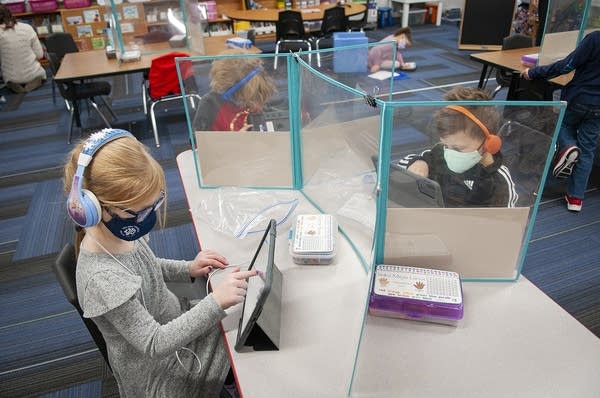COVID-19 spike sending Minnesota students home, closing schools
Some schools are changing mask and safety policies to thwart a rise in infections.

Go Deeper.
Create an account or log in to save stories.
Like this?
Thanks for liking this story! We have added it to a list of your favorite stories.
Last Thursday, families in the Shakopee Public School district got notice that all classes would be canceled for Thanksgiving week.
“In our district, the three weeks with the most COVID-19 infections per week since the beginning of the pandemic have all occurred this month,” an announcement on the district’s website read.
COVID spread had already forced leaders to move three classes from in-person to distance learning, and was threatening to do the same to several more. District leaders decided to cancel all classes for the week of Thanksgiving, “In order to address current pandemic concerns and hopefully slow or decrease the rising number of COVID-19 cases.”
Virus spread has forced many classroom and even grade-level shutdowns and quarantines this academic year.
Turn Up Your Support
MPR News helps you turn down the noise and build shared understanding. Turn up your support for this public resource and keep trusted journalism accessible to all.
In the North St. Paul-Maplewood-Oakdale district, two schools are in remote learning and an entire class of seventh graders in another school have also shifted to online lessons. The Red Lake district has moved all its students to distance learning through the end of the year. South Washington County has moved two classes to distance learning and in Rochester a middle school moved all their sixth grade students to online schooling.
“We are seeing incredibly high case rates right now and it’s definitely affecting our schools,” said North St. Paul Superintendent Christine Tucci-Osorio. “We’ve been really, really trying to keep students in school but there’s been some cases where we’ve had to shut down either a classroom or at times a whole grade level or a whole school. It just became unsafe to be in there.”
Virus spread has also spurred school leaders to change their health and safety policies.
In North St. Paul, district leaders have made their masking policy stricter, asking staff to wear masks even when no students are present. Minnetonka's Groveland Elementary has updated its social distancing and masking policies during meals. And in South Washington County schools, district leaders have decided that, following the Thanksgiving break, they will introduce increased health and safety measures in their elementary buildings. They’ll start limiting movement in buildings — moving lunch from the cafeteria to classrooms, separating students during recess and asking specialist teachers to visit classrooms instead of sending students to other parts of the building.
“It’s almost like quarantining within the school,” said Pepe Barton, South Washington County Schools director of communications.
Minnesota school leaders have repeatedly insisted that one of their main goals this year is to keep students learning in person. Despite the increasing number of closures and temporary switches to distance learning, that goal is in large part being met — especially compared to the large number of closures that happened in October and November last year.
In November 2020 about 60 percent of Minnesota K-12 students were in distance learning after many districts used the Thanksgiving break to pivot to virtual lessons.
This year is very different for a number of reasons: many more students and educators are vaccinated, meaning they don’t need to be quarantined in some cases following exposure to COVID-19. But in large part schools are open because of policy changes. They’re no longer required to send students home based on county case rates. Now they’re making decisions to close or move to remote learning based on how many students in a certain class or building are getting sick. And of course, staff infections — including an increase in breakthrough cases among staff members — and shortages are also contributing to closures in some cases.
“One of our primary goals right now is to keep students in school and in person as much as possible. Probably our largest risk for having to go to distance learning, whether it’s in the classroom or school, would be staff shortages. Depending on whether there’s illness with the staff or we just can’t find substitutes,” Barton said.
The availability of the COVID-19 vaccine for ages 5 to 11 may make a difference to many schools being able to keep their doors open in coming weeks and months.
“The vast majority of cases have actually been in our youngest elementary and middle school where there’s probably a little lower vaccination rates at this point,” said North St. Paul’s Tucci-Osorio. “The places where we’ve had to close things down have been elementaries and middle (schools). ... As more and more students get vaccinated, I think we’re going to have better success keeping everybody in school and not shut down classrooms.”


